Undergraduate research on Capitol Hill: Colleges of Science and Agriculture and Applied Sciences
Editors note: This is part one of a three part series outlining the research undergraduate students took to Capitol Hill last February. Click here for parts two and three.
Utah State University’s Research Week gave students and faculty the opportunity to share and learn about the different research efforts being conducted on campus.
Hosted by the department of Research and Graduate Studies, Research Week held several events including the Faculty Author Exhibit, Ignite USU and the Student Research Symposium.
Last February, the RGS gave several undergraduate researchers the opportunity to take their projects to Capitol Hill in Salt Lake City. They presented on various topics from saving bees to helping children learn mathematics. In honor of Research Week, they have shared their projects with The Utah Statesman.
College of Science
Melena Garrett and Riannon Smith
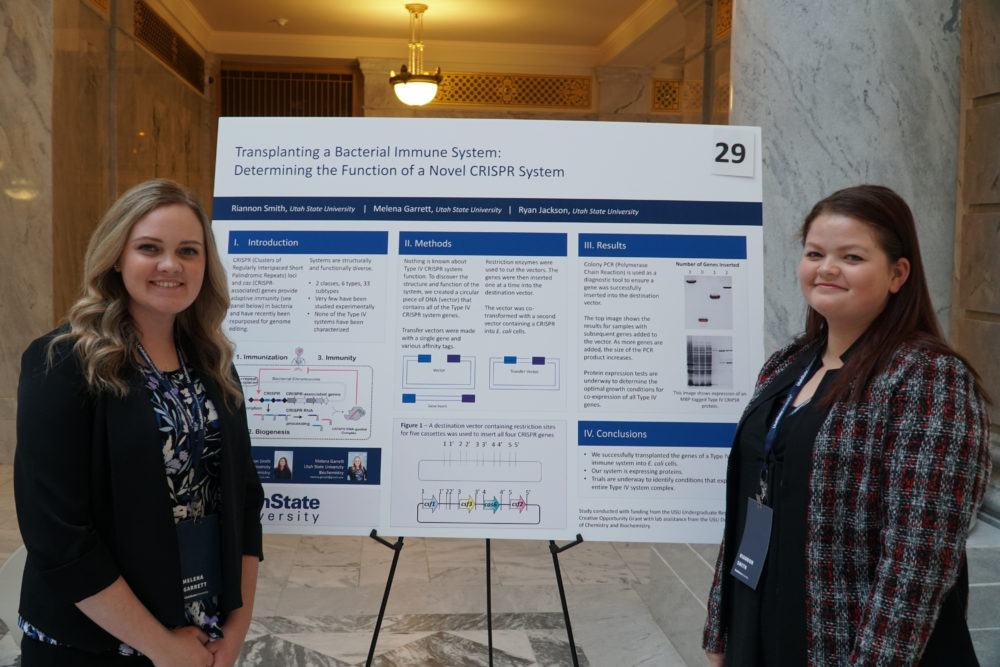 Tyler Grow
Tyler Grow Melena Garrett and Riannon Smith are biochemistry engineer students. This major led them to becoming interested in researching Clusters of Regularly Inter-spaced Short Palindromic Repeats .
“CRISPR’s have genome editing potential. These systems that we are working on we don’t know what they do. We are trying to expand the basic knowledge of these CRISPR systems,” Smith said.
The pairs research involved moving one form of bacteria to another then expressing the proteins to form an entire CRISPR complex. This tells Garrett and Smith how the proteins work together. This complex research had some problems along the way. A experiment doesn’t always go as planned according to Garrett and Smith.
“You have a protocol and expect it to work, but sometimes the cells just might not be feeling it that day,” Garrett said.
Mikayla Austin
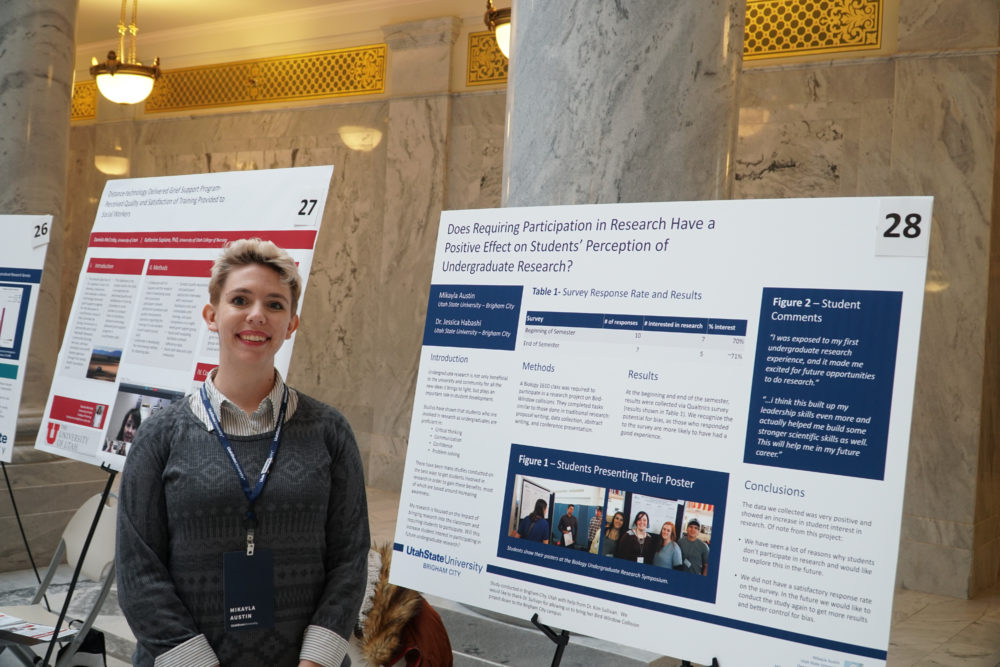
Mikayla Austin’s project was essentially research about research. Austin is working to figure out how to get more students interested in doing research. Austin is a video game-loving mother of two, so this research project was a personal goal for her.
“When I came to school I really wanted to get involved in research, but it was also intimidating. I didn’t know if I was experienced enough and I am also a student in Brigham City so we have a lot less resources to work with,” Austin said. “It was a personal thing for me and it changed the way I looked at research.”
Austin worked in a biology class with students who were working on a research project. She followed these students throughout the semester to see what impact their research was having.
“The most surprising thing is that it was actually really easy to get the students excited about doing research. I was worried we might scare some people off, but it was surprising how well it was received and the students enjoyed it and saw the benefits,” Austin said.
Joshua Hansen
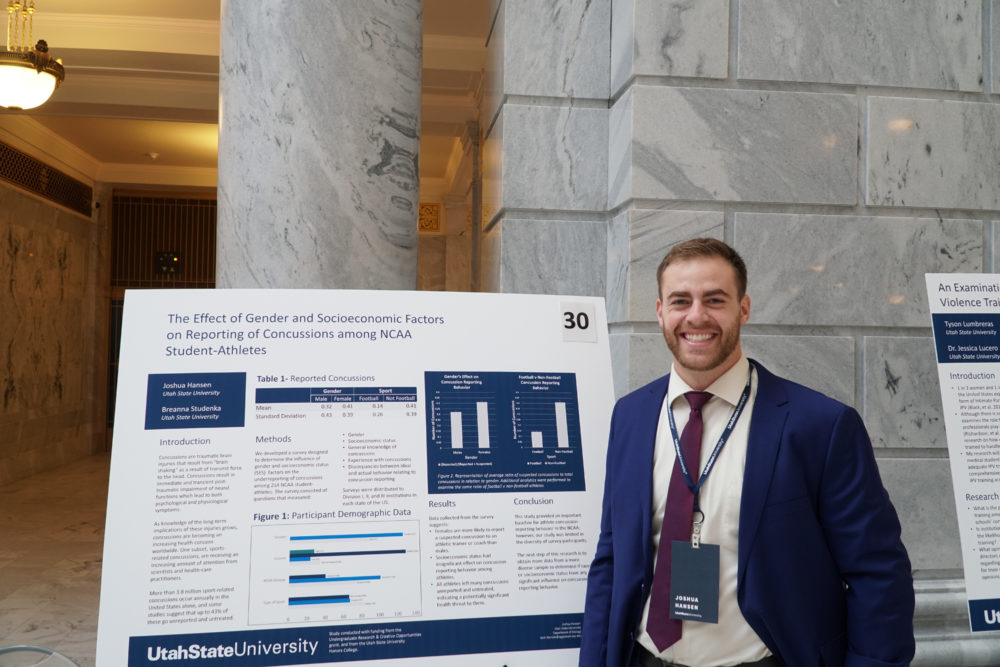 Tyler Grow
Tyler Grow Researcher Joshua Hansen looked into finding out more about athletic concussions. He researched the way concussions are reported and which types are athletes are more likely to report concussions. “It’s estimated that over half of concussions sustained during participation in National Collegiate Athletic Association go unreported for various reasons. My research was aimed at determining subgroups of NCAA student-athletes that were less likely to report concussion symptoms to a coach or athletic trainer,” Hansen said.
Concussions are a serious issue in the world of college athletics. Researching this issue more in depth will lead to better treatments and safer athletes.
“Perhaps the most surprising thing I learning in my research was the lack of differences in reporting behavior between student-athletes from different cultures and socioeconomic backgrounds; it suggests that individuals form new social groups and follow common norms different from those of society. This supports the idea that sports are a platform where individuals come together, no matter their background,” Hansen said.
Garett Rydalch
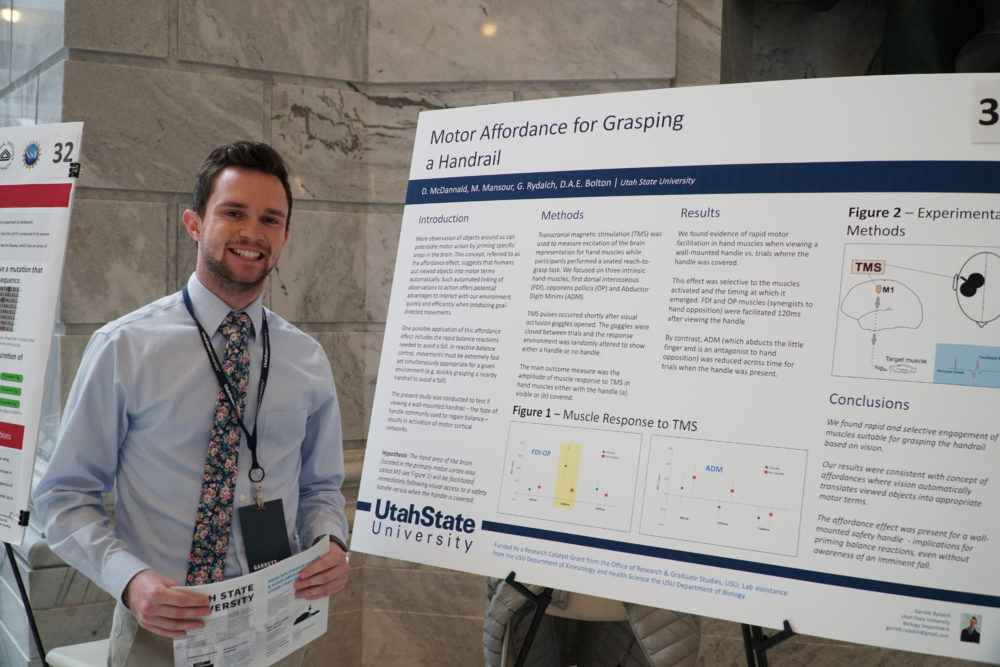 Tyler Grow
Tyler Grow Rydalch wants to help reduce falls in old people. His project research looked into how specific hand muscles are activated based on vision.
“What we found was this activation of these hand muscles and compared younger adults vs older. This activation declines in older people,” Rydalch said. “If further down the line if we can improve these connections and restore this activiations maybe that would help reduce the number of falls in older people.”
In this field there is a lot of unknown about what goes on in our brains before a fall. Rydalch hopes his research will shed more light on this topic.
“We are working on a new project where we use a computer test to see if there is a correlation between that and balance. It could be used as a test for later on along with similar projects that help us further understand it,” Rydalch said.
Matthew Thompson
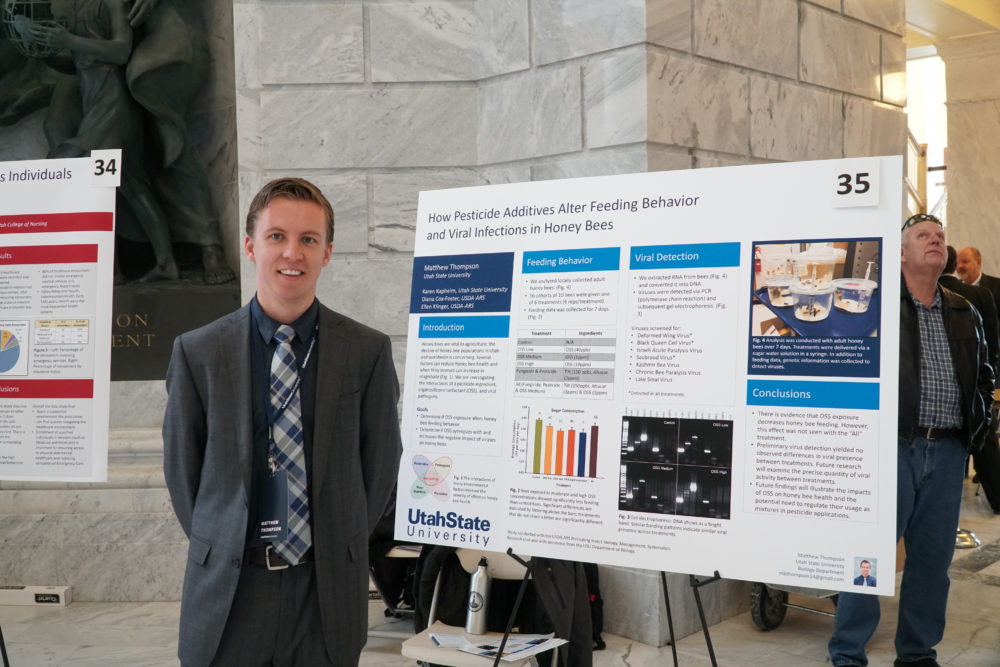 Tyler Grow
Tyler Grow “I worked in the lab over the summer and we had a somewhat competition of who got the most bee stings. I only got one. Some of my coworkers got a lot worse than me,” Matthew Thompson said.
Thompsons research involved working with bee populations to figure out why they are declining. He is looking at a particular chemical that is commonly used in pesticides to see what effect it has on bees.
“ You know bees help me so I’ll help them back. One in every three bites we can thank a pollinator for. With this research we ultimately are helping ourselves. Bees do things that we cannot,” Thompson said.
Tomoson took his research to the capitol to help raise awareness for this issue. In the future he hopes to attend a graduate school and apply the skills that he has gained through research. His next step for this project will be looking at the DNA information of the bees.
James Withers and Loren Linford
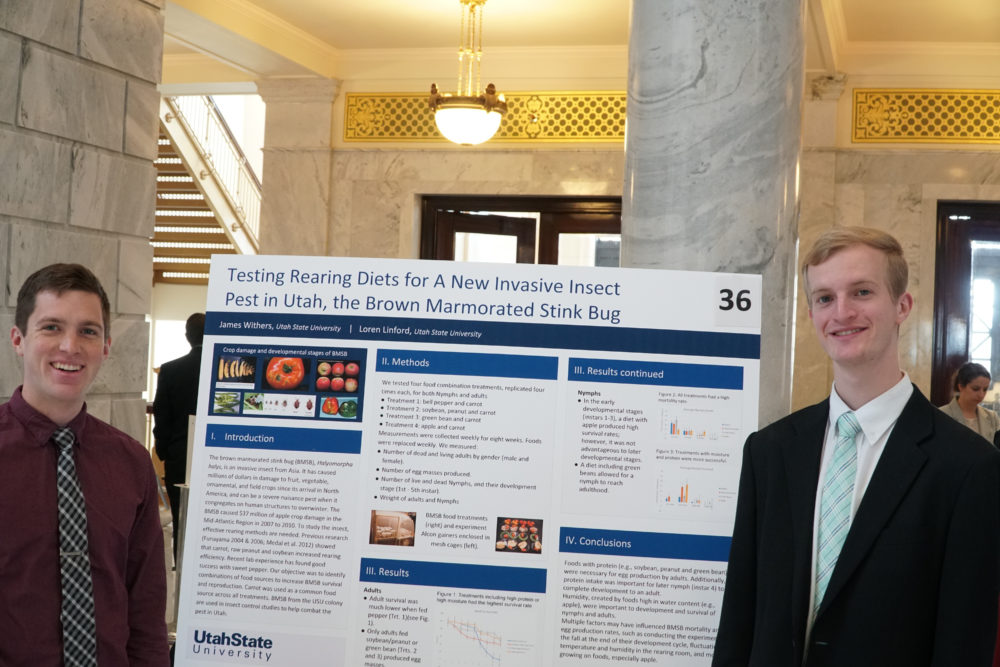 Tyler Grow
Tyler Grow Withers and Linford are both entomologists at Utah State University. There is a stink bug colony at USU that Withers and Linford did their research with. They were looking at what type of diet would increase stink bug rearing, and through this know how to manage them effectively.
“We came up with a project that would bring a high amount of eggs and survival rates. There has been millions of dollars of crop damage because of these bugs, so we wanted to study how to fix that,” Withers said.
Withers and Linford were excited for the opportunity to share their thoughts with lawmakers at the Capitol.
“It was cool that we were invited to share. Those lawmakers are there to help the public, and by having them listen to us they can create a lot of change,” Linford said.
Tyson Lumbreras
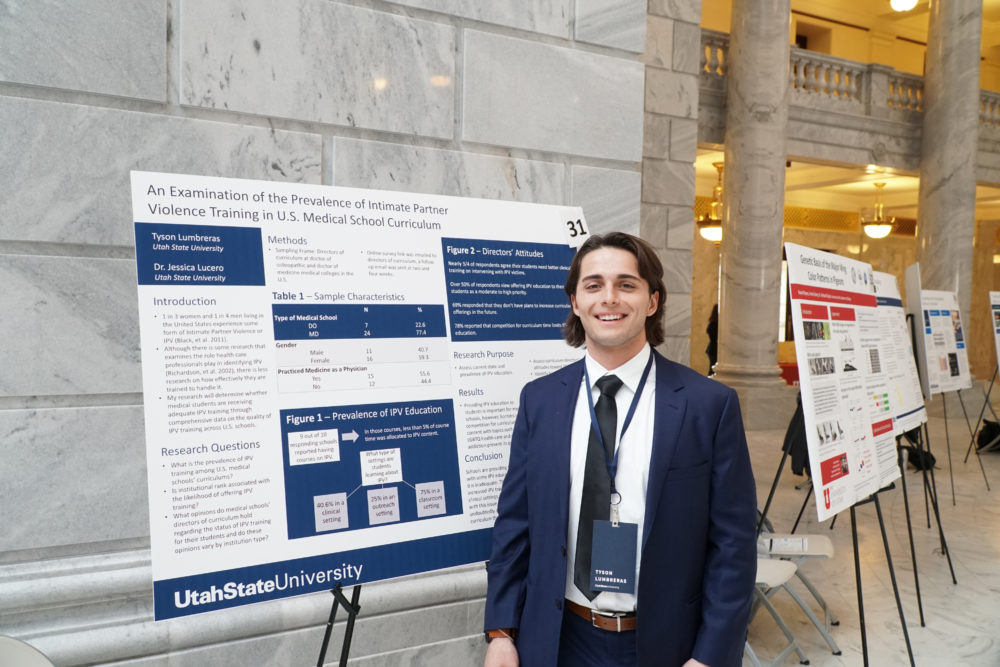 Tyler Grow
Tyler Grow Researcher, Tyson Lumbreras set out to answer the question are our medical professionals being adequately trained on how to deal with domestic violence patients? Lumbreras became interested in this public health issue through previously working alongside CAPSA.
“I volunteered for CAPSA and part of my responsibilities were going to the ER 24 hours whenever I was needed. I would go and help a domestic violence patient through that process. While doing this I noticed that some doctors were more knowledgeable than others on this issue,” Lumbreras said.
Lumbreras sent out surveys to all 188 accredited medical schools in the United States asking about their domestic violence trainings for students. Many of these schools responded saying that do not feel that their students receive adequate training on this public health issue.
“With this research it is a great starting point to advocate for more training on domestic violence for any medical professional,” Lumbreras said. “I think the next step is asking what can we do to increase domestic violence training. What can we do this implement this more frequently in the four years of medical school.”
AJ Walters
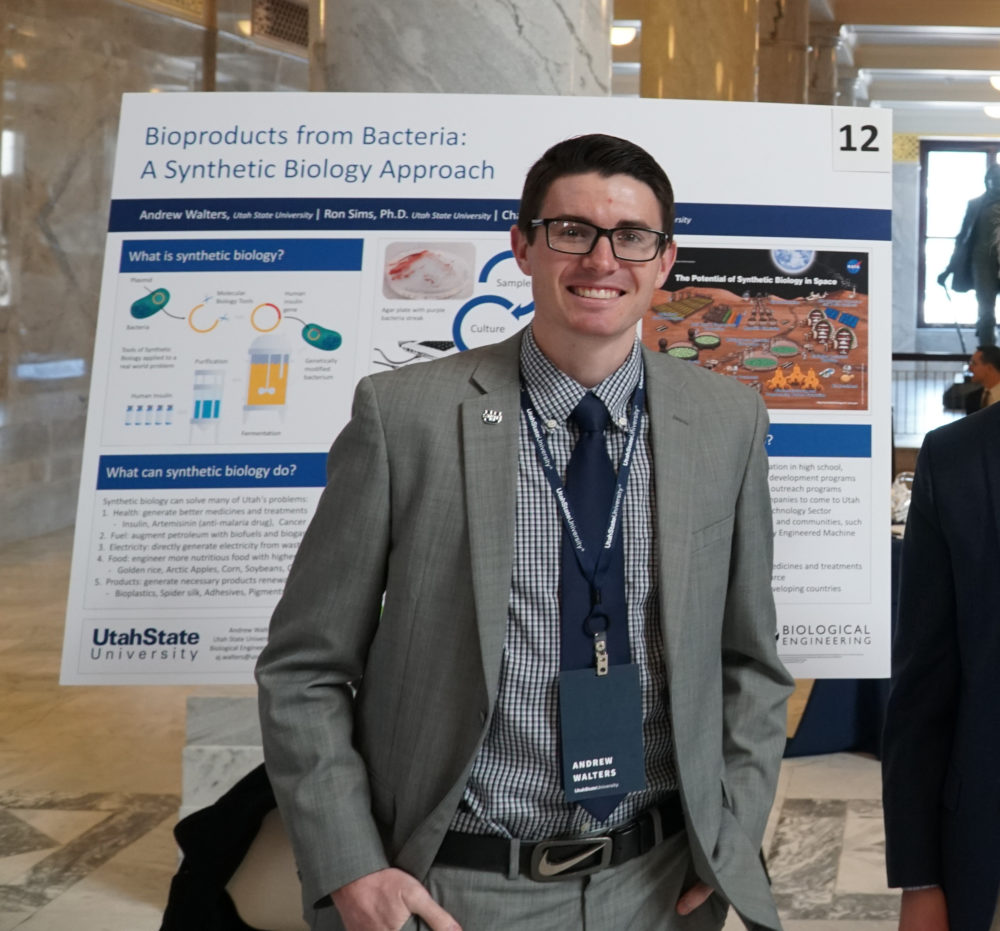 Tyler Grow
Tyler Grow AJ Walters is a biochemistry engineering student at Utah State. He wants to promote synthetic biology as an industry in Utah.
“Utah has done a really good job of jumping on the silicon train, but we don’t have anything in the carbon sector. What would it take to turn Utah into the next biotechnology hub of the United States,” Walters said.
This is what led him to present his research on Capitol Hill. Walters’ research was focused around producing useful products from bacteria. By inserting a gene into bacteria, he hopes to produce versatile and useful proteins that can create plastics, hydrogen gas and help treat wastewater.
“We are trying to take waste and turn it into energy or plastics we can use,” Walters said.
Walters got into his research when he was very young, after reading the book “Jurassic Park.” Instead of the dinosaurs, it was the genetic cloning that really fascinated him.
“I got really into genetic research, and started working on that through college, and that is how I ended up where I am. It is really fascinating to me,” Walters said.
Anders Hart
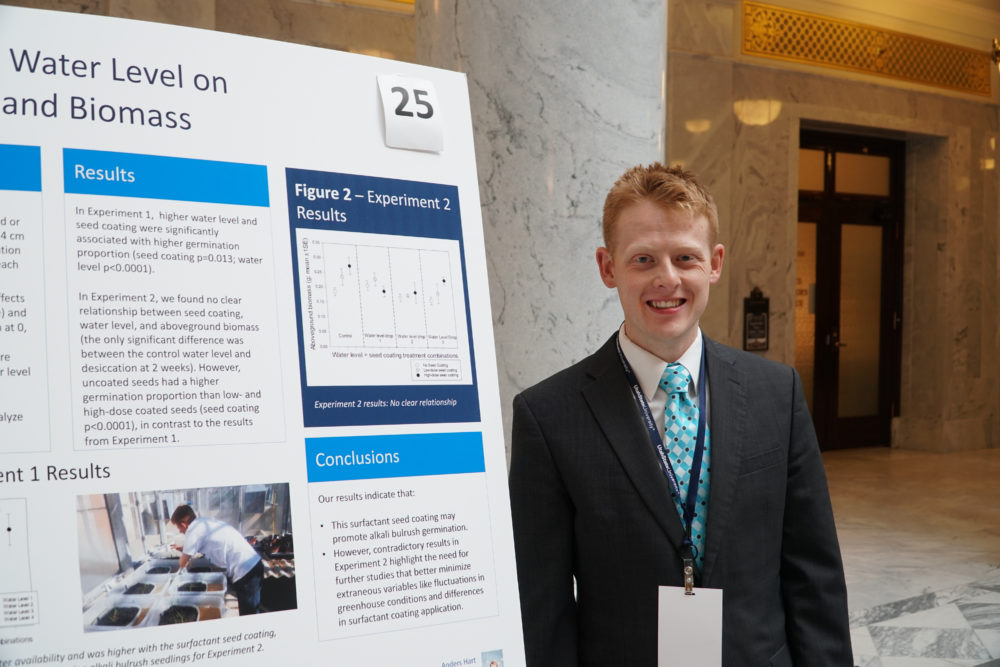 Tyler Grow
Tyler Grow Anders Hart is studying conservation and restoration ecology at Utah State. He wants to know if seed coatings will help prevent the extinction of certain species in the Salt Lake area.
Hart focused on the Salt Lake area because invasive species are moving in on the area. He wants to avoid wiping out the native species, and thinks that seed coatings may help these species in danger germinate better and grow faster, decreasing their chance of extinction.
“This affects the Great Salt Lake, which we all depend on. It is such a huge part of the environment here in Utah from fishing to bird watching. These threatened native species are essential for all of these things,” Hart said.
Hart did two greenhouse experiments. The first experiment found that the seeds with the coating did increase the rate of germination of the seeds. The second experiment found the same thing, but when the plants allowed to grow for longer, the relationship between coating and germination was not clear. Hart plans to continue his research to find this relationship in the fall.
College of Agriculture and Applied Sciences
Tess Armbrust and Canyon Neal
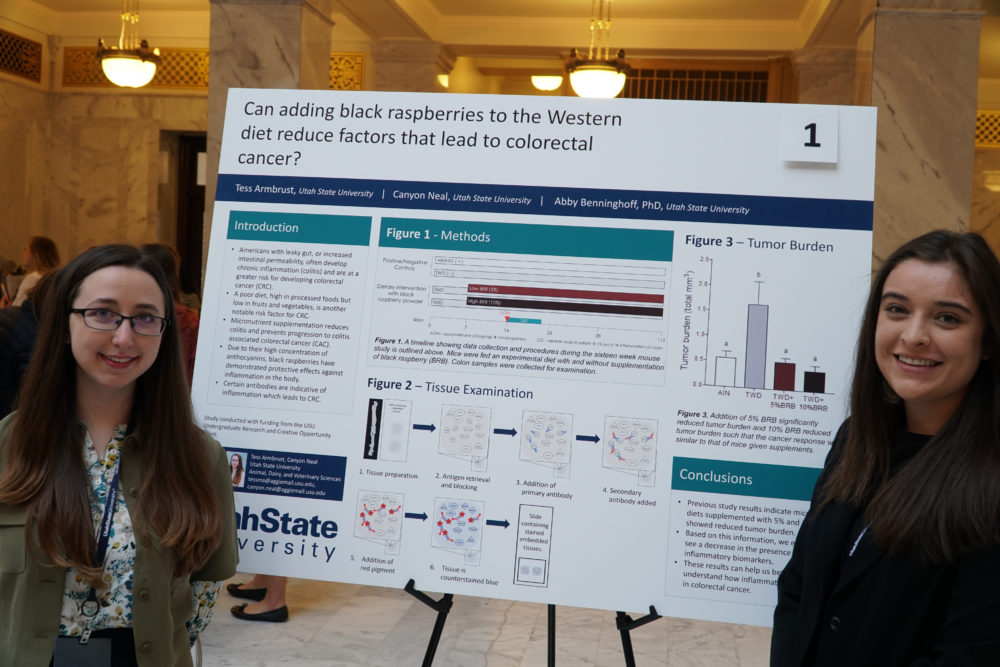 Tyler Grow
Tyler Grow Tess Armbrust and Canyon Neal’s research connected black raspberries and colon cancer. They researched how adding black raspberries to your diet will affect internal inflammation and your risk of getting colon cancer.
“Our research project studies the impact of a Western type diet and supplementation with black raspberries on biomarkers of inflammation in the colons of experimental mice,” Armbrust said. “We wanted to better understand how inflammation plays a role in colorectal cancer and the biomarkers that are involved.”
Through using mice in their research the pair was able to see how this same process could affect humans too.
“Others should care about this research because the more we know about gut inflammation and the biomarkers involved, the easier it will be to determine the best way to risk of inflammation-associated colorectal cancer,” Armbrust said.
Boston Swan
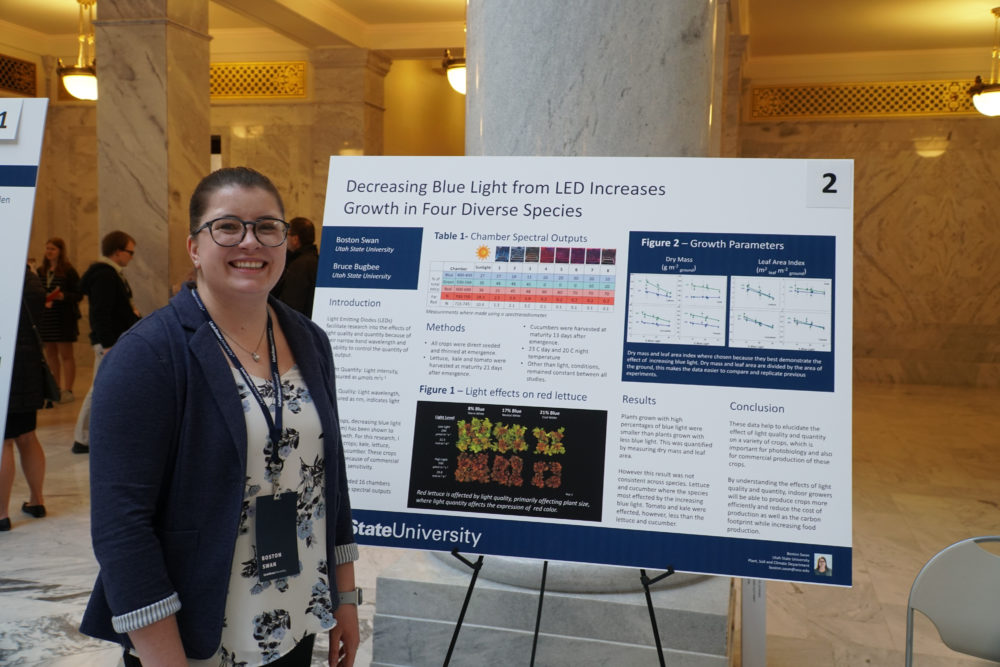 Tyler Grow
Tyler Grow Boston Swan was able to use her love of plants in her research project. She was studying photobiology, essentially, how plants are affected by light.
“I chose this topic because I have always loved plants and I found it super fascinating that we could affect plant growth based on the lights they were grown under,” Swan said. “This project perfectly married my love of plants with my fascination with technology. I am trying to optimize plant growth by controlling the intensity and wavelength of light the plants are grown under.”
Swan tested four different types of plant with different light variations. Through this process she was able to understand plants better.
“I learned how truly amazing plants are. They can acclimatize and grow in almost any situation you put them in. I was truly surprised at how much we could change and still end up with a very happy plant,” Swan said.
Andrea Jo Johnson
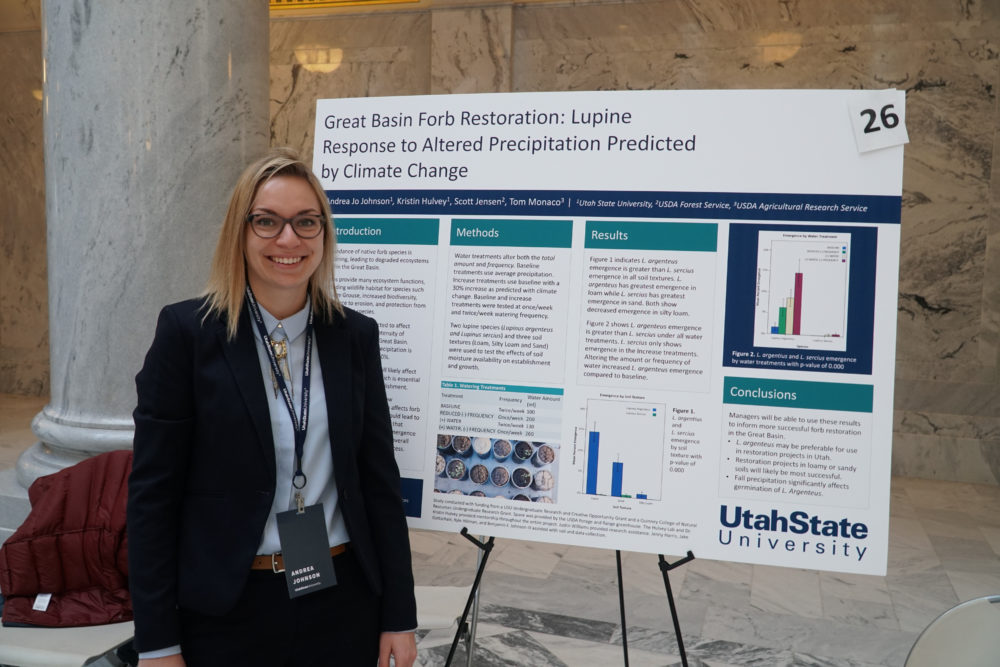 Tyler Grow
Tyler Grow Andrea Jo Johnson is studying conservation and restoration ecology at Utah State. She wants to know how forbs grow in the Great Basin and how this affects restoration of different species.
Forbs are annually flowering plants. “What you would usually think of are wildflowers,” Johnson said. She focused on two lupine species of forbs.
By altering soil types and water amounts, Johnson hoped to find what worked best for these species to flourish.
She altered the amount of water given to the plants to mimic what is expected due to climate change in the fall.
One of her lupine species did not do well, but the other flourished. “It liked the increased amount of water I gave it and decreased frequency of water, which is what we expect to see precipitation-wise in the fall,” Johnson said.
The three different soil types were chosen based on what is commonly found in the Great Basin. The two soil types that allowed the greatest growth were silty and sandy soils. The one that did not help the plants was a sandy-clay type soil.
They responded well to what we would expect to see in the fall, but I am not sure about other seasons,” Johnson said. “I look forward to finding more out about this.”
To view each undergraduate’s abstract look here.
— shelby.black@aggiemail.usu.edu
@shelbsterblack
—brianne.sorensen@aggiemail.usu.edu
@SorensenBrianne

